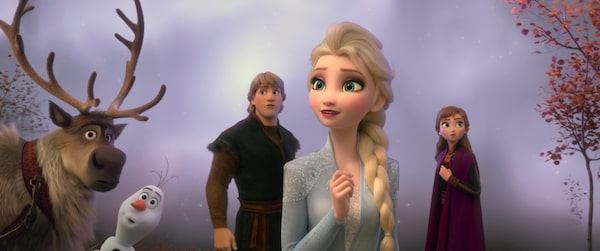
The adventures of Elsa, Anna and friends continues in Frozen 2, which comes out in theatres this week.© 2019 Disney
Let it go. Let it go. Can’t –
And then you did it, didn’t you, as instinctively as a cartoon snowman seeking cold temperatures. You sang the rest of that famous chorus. Probably not out loud, but in your head those soaring words soared: Can’t hold it back anymore.
Let It Go, from the Disney movie Frozen, became the ultimate earworm when the film was released in 2013. The clip featuring Elsa singing the song has been viewed more than 2.9 billion times on YouTube, and the song propelled the soundtrack to bestselling album status in 2014, beating both Taylor Swift and Ed Sheeran.
With the sequel now in theatres, Disney is no doubt hoping that Into the Unknown, the standout song from the film, will prove to be another megahit. A cover of the song, by the band Panic At The Disco, has been viewed more than 4.4 million times online since it was released earlier this month.
But it’s not likely to make the same mark as Let It Go or other popular children’s songs such as Baby Shark, says Beatriz Ilari, an associate professor of music education at the University of Southern California.
“I don’t think we’ll have to listen to it a billion times,” she says.
Popular songs tend to share a particular set of elements that make them hits, researchers say. You can actually put someone in an MRI and watch areas of the brain associated with anticipation and pleasure light up as people listen to them. Let It Go nailed almost all of them, but Into the Unknown lacks at least one of these crucial elements: Its complex melody makes it too hard to sing, Prof. Ilari says.
Almost all hugely popular children’s songs tend to be both musically and emotionally upbeat with simple, catchy melodies, Prof. Ilari says.
The Pharrell Williams song Happy, from the movie Despicable Me 2, and Justin Timberlake’s Can’t Stop the Feeling, from Trolls, are two perfect examples, she says.
“For kids, upbeat is something that really catches their attention,” she says.
Add a heavy dose of repetition – think “The wheels on the bus go round and round” – and you are on your way to a song kids can’t get out of their heads and will want to listen to over and over again, she says.
This explains why a version of Baby Shark, a simple, bouncy song that is easy to sing and repeats its lyrical refrain seemingly endlessly has been viewed online more than 2.2 billion times.
“That’s part of the reason little kids like repetitious songs, because they know what’s coming and it’s easy for them to grasp,” says Jessica Grahn, who runs the Music and Neuroscience Lab at the University of Western Ontario.
When a song builds to a soaring chorus, the way Let It Go so perfectly did, it lights up the caudate nucleus, a part of the brain involved in stimulus-response associations, Prof. Grahn says. That buildup is pleasurable to kids and adults alike because we know a reward is coming. When we get that reward, such as when Idina Menzel belts out the chorus to Let It Go, it activates the nucleus accumbens. “This is one of the areas where you see dopamine release in response to food and sex,” Prof. Grahn says.
Let It Go differs from many other popular children’s songs in that it deals with strong, complex emotions – it’s not purely feel good pop, says Tyler Bickford, author of Tween Pop, a book about the popularity of pop music among tweens, which will be published next spring.
“It’s full of interior, deep feeling,” he says. “No shade against good kids’ music, but strong emotions are not the main theme of a lot of kids’ music.” But it balances that emotional complexity with an upbeat, straightforward melody.
Into the Unknown is, like its predecessor, more emotionally complex than typical children’s fare. “I’m afraid of what I’m risking if I follow you into the unknown,” goes one line of the song. And it repeats the refrain “into the unknown” several times. But it seems to have one crucial flaw, Ilari says. “It’s very difficult to sing,” she says. “There’s a lot of modulations in the music. That is really, really difficult.”
After listen to the song, Mr. Bickford said it “doesn’t seem like a huge crossover hit.”
“It barely seems to be trying to repeat Let It Go. Which, maybe, you have to respect. One-hit-wonder follow-ups never really work out,” he said.
While Let It Go built to a glorious moment of emotional release in its chorus, the new song seems to lack that same power. If kids aren’t stirred by it the way they were with Let It Go, they won’t be listening to it on repeat. “The emotional catharsis – everybody enjoys that. Kids are no different from anyone else in that,” Mr. Bickford says.
Just like Let It Go, the new song was written by Kristen Anderson-Lopez and her husband, Robert Lopez, and will be sung in the movie by Elsa herself, Ms. Menzel.
Perhaps they will catch lightning in a bottle twice. But if the earworm experts are right, audiences will hear the song and, well, let it go.
Our Morning Update and Evening Update newsletters are written by Globe editors, giving you a concise summary of the day’s most important headlines. Sign up today.
 Dave McGinn
Dave McGinn